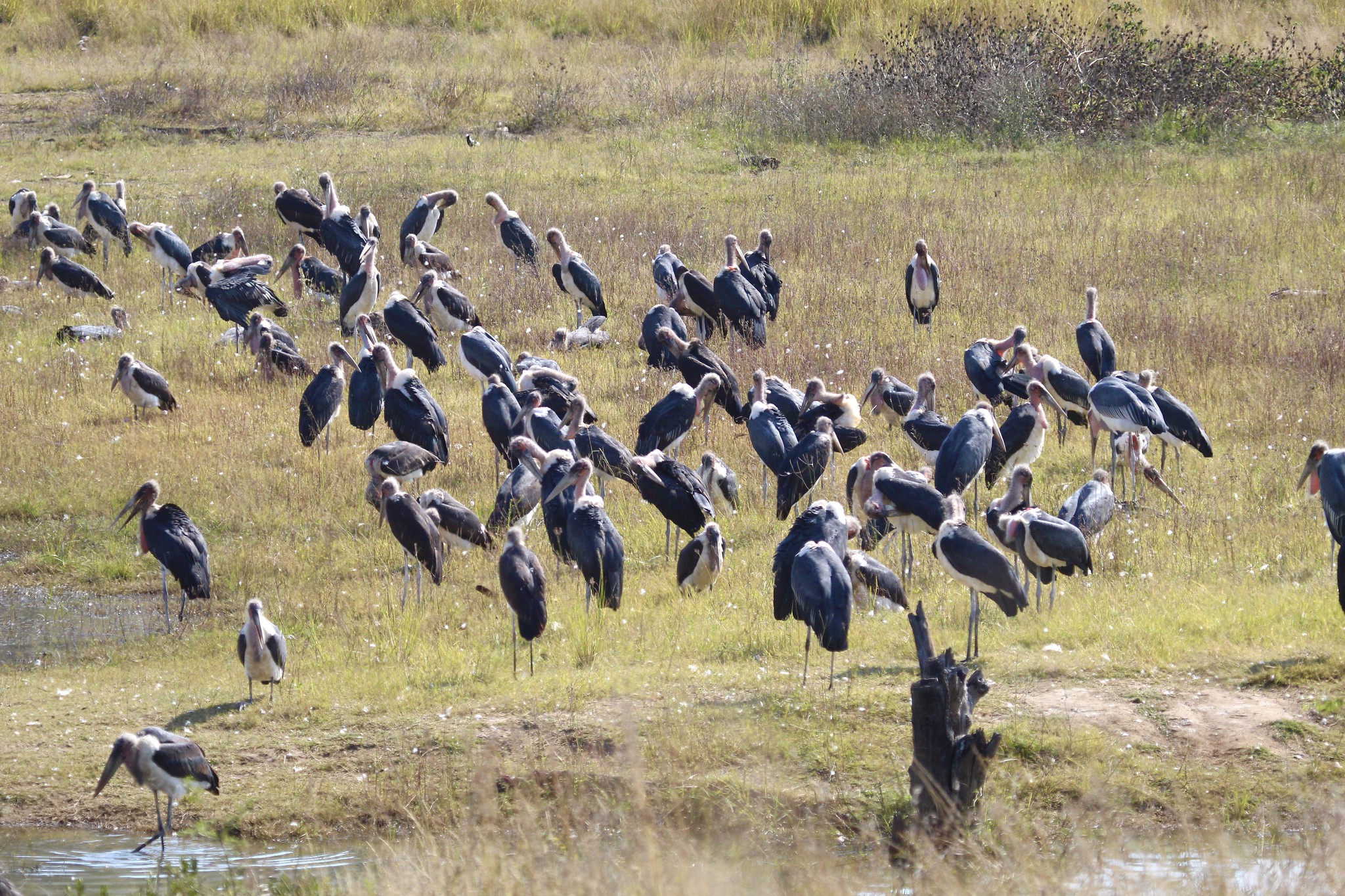Exploring the marabou stork reveals a world where size and strategy combine for survival. This article uncovers marabou stork facts, shedding light on its gigantic wingspan, temperature control tactics, and ecological impact. Ready to grasp the scale and sophistication of one of Africa’s most awe-inspiring birds?
Key Takeaways
The marabou stork is notable for its massive size, large wingspan of up to 3.7 meters, distinctive features such as a bare head and neck, which facilitate cleanliness, and a gular sac used in courtship displays.
As scavengers with adaptive feeding strategies, marabou storks have a varied diet, including carrion and small animals, and demonstrate opportunistic behavior by following grass fires and vultures to find food.
Marabou storks are considered Least Concern on the IUCN Red List due to their increasing population, showing adaptability to changing environments and resilience amid threats like hunting for traditional medicine.
Unveiling the Marabou Stork
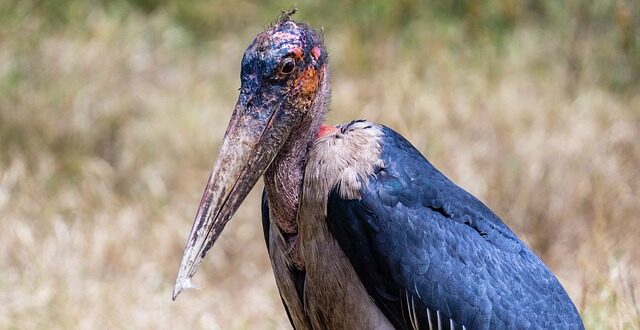
The marabou stork, known for its massive bird stature, is a spectacle. These birds typically reach a height of 150 to 152 centimeters and weigh around 9 kilograms, making them one of the larger bird species in the world. But their size is not the only one that sets them apart. The marabou stork’s wingspan can extend up to a stunning 3.7 meters, placing them among the birds with the largest wing spreads.
Their massive size doesn’t hinder their ability to fly. Thanks to the hollow bones in their legs and toes, these birds can maintain efficient flights despite their size. This adaptation is a testament to nature’s incredible ability to evolve and adapt, even in the face of seemingly insurmountable challenges, not only for birds but also for small mammals.
Distinctive Features
The marabou stork is easily identifiable by its distinct features. It has a bare head and long neck, which are physical adaptations that facilitate cleanliness after feeding on carcasses. This is one of the many examples of how the marabou stork perfectly adapts to its scavenger lifestyle.
Another unique feature of the marabou stork is its use of defecation as a cooling mechanism. By defecating on their legs, these storks can regulate their body temperature in the hot African weather. This also gives their legs a distinct white coloration, adding to their unique appearance.
Another striking feature is the gular sac on the marabou stork’s throat. While it’s not used to store food, it may be inflated during courtship displays, adding to the bird’s intriguing behavior with its neck retracted.
Size Comparison
When it comes to size, the marabou stork is truly in a league of its own. Along with the Andean condor, which has an average Andean condor wingspan of up to 3.7 meters, it boasts the largest wing-spread of any living bird. To put it in perspective, that’s more than twice the height of an average person.
This massive wingspan allows the bird to soar effortlessly above the savannas of Africa, scanning the ground for potential meals. The sight of a marabou stork in flight, with its cloak like wings spread wide, is a sight that once seen, is never forgotten.
The Diet of the Undertaker Bird
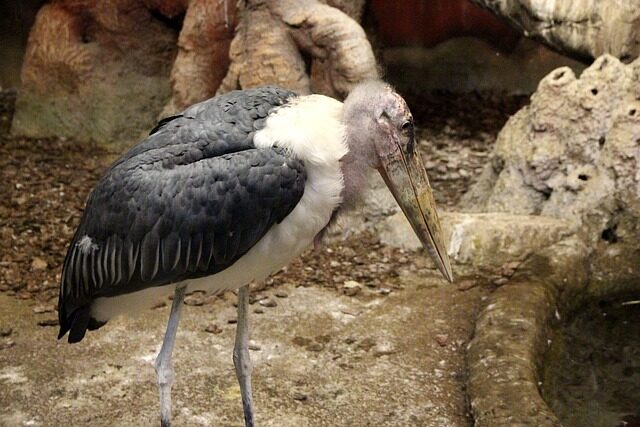
The marabou stork’s diet is as fascinating as its physical features. As scavengers, their primary diet consists of carrion. However, these birds are far from picky eaters, their menu includes a diverse array of prey such as:
termites
locusts
frogs
lizards
baby crocodiles
snakes
rats
mice
other birds
This diverse diet plays a significant role in maintaining the balance within ecosystems by controlling the spread of diseases.
In order to meet their dietary needs of over 700 grams (1.6 pounds) of food daily, marabou storks demonstrate adaptive feeding strategies. One such strategy is following grass fires to seize fleeing animals. This opportunistic behavior underscores their intelligence and adaptability in finding food sources. However, the encroachment of human habitation has led to a shift in their traditional diet, with marabou storks increasingly feeding on waste at landfills, which includes ingesting large quantities of plastic.
Opportunistic Feeding Habits
Marabou storks have an array of tactics to catch their varied prey. They wade in shallow water to catch fish and frogs, using their sensitive bills to sense and swallow prey whole. Their proficiency in soaring over open territories during the day allows them to look for prey from the air, showcasing their hunting versatility.
These storks are also known to follow vultures to feed on carrion, demonstrating their opportunistic nature. In fact, marabou storks often gather in groups by water bodies, sharing scavenging sites with vultures. This social foraging behavior is another testament to their adaptability and resourcefulness.
Adaptations for Scavenging
Several physical adaptations facilitate the marabou stork’s scavenging lifestyle. They have strong beaks and tough toe bones, enabling them to break through the hides of large dead mammals and scavenge on the carcasses. This ability to break down tough materials allows them to access food sources that many other animals can’t, giving them an advantage in their environment.
Moreover, the hollow construction of the marabou stork’s leg and toe bones aids them in sustaining flight despite their size. This is crucial for scavengers that often need to cover large distances to find food. These adaptations, combined with their intelligent feeding strategies, make the marabou stork a master scavenger, perfectly equipped for survival in the diverse ecosystems of Africa.
Behavior and Social Structure
Apart from their distinctive physical characteristics and feeding habits, marabou storks also exhibit interesting social and behavioral traits. While they are largely solitary creatures, they tend to form groups during activities such as foraging, migrating, and breeding. This social behavior is particularly evident when they congregate near water bodies such as lakes or rivers.
Marabou storks exhibit opportunistic behavior by:
Following grass fires to seize fleeing animals, such as monitor lizards
Being attracted to areas where lions have made kills
Frequently accompanying herds of large mammals, using the disturbance caused by these animals to catch insects.
Another distinctive behavior observed in marabou storks is their tendency to stand largely motionless for long durations. Combined with their unique physical features, this behavior gives them an almost mythical aura in the animal kingdom.
Breeding and Nesting
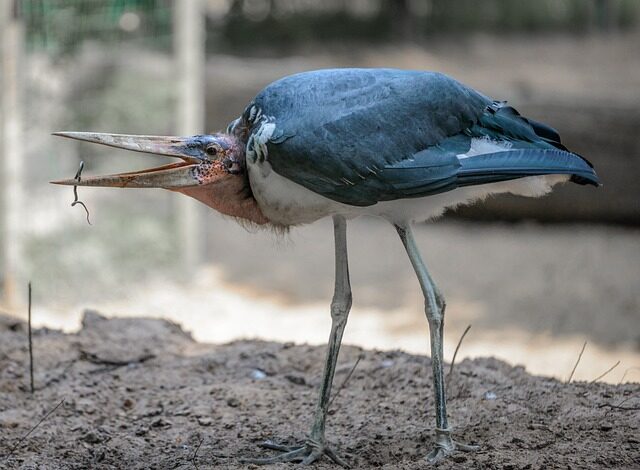
The breeding and nesting habits of marabou storks are also worth exploring. These birds:
Form lifelong pair bonds
Engage in distinctive bill-rattling courtship displays to attract and maintain mates
Lay 2-3 eggs during the dry season
Undergo an incubation period of approximately 30 days, handled by both parents
Marabou storks, like most storks, exhibit the following behaviors when raising their young:
Constructing large nests made of sticks in trees
Lining the nests with twigs and green leaves
Shifting their diets to predominantly small, live prey throughout the breeding season
These behaviors illustrate the care and effort that marabou storks put into raising their young.
Temperature Regulation Tactics
Living in hot environments, marabou storks have developed interesting tactics for temperature regulation. One such tactic is defecating on their skinny white legs. This cools down their bodies and also gives their legs a distinct white coloration, further adding to their unique appearance.
In addition to this unusual cooling method, marabou storks also pant to expel excess heat from their bodies. These temperature regulation tactics underscore the bird’s adaptability to its environment and its resourcefulness in survival.
Habitats and Range: From Arid to Aquatic
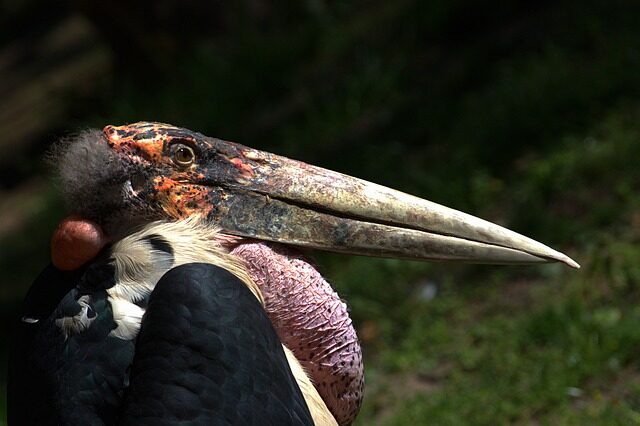
Marabou storks inhabit a variety of ecosystems throughout Africa, including:
Arid savannas
Wetlands
Open dry savannas
Grasslands
Swamps
Riverbanks
Lake shores
Their natural habitats extend across the tropical regions below the Sahara Desert, including arid habitats and the africa south region.
Their long legs and necks make them well-adapted to aquatic settings for wading, and they are often seen in groups near bodies of water such as lakes and rivers. These diverse habitats underline the marabou stork’s adaptability and its ability to thrive in a wide range of environments.
Adaptability to Human Presence
Interestingly, marabou storks have shown an impressive ability to adapt to human presence. They have become increasingly dependent on human garbage, devouring almost anything they can swallow. Consequently, they are often found in garbage dumps and urban areas.
They have adapted to forage in shallow waters in urban environments, relying heavily on human waste for nourishment. They are found in various terrains from savannas to open, semi-arid areas and often associate with humans near settlements such as fishing villages and garbage dumps. This adaptability underscores their resilience and versatility, even in the face of drastic changes in their habitats.
Conservation Status: Threats and Protections
Despite their increasing interaction with humans, marabou storks are not significantly threatened. Due to their increasing population numbers, they are classified as Least Concern (LC) on the IUCN Red List. However, they do face some threats, particularly from hunting. In Nigeria, they are hunted for use in traditional medicine markets.
Yet, their resilience is evident in their ability to thrive despite these threats. Marabou storks exhibit resilience through:
Their ability to adapt to different habitats and not being significantly affected by habitat loss
Their ability to withstand the impacts of climate change
Their large range, indicating a lack of vulnerability based on range size criteria
This resilience allows them to continue thriving in various environments.
The IUCN Red List and Population Trends
The marabou stork’s status on the IUCN Red List is a testament to its resilience. The bird does not meet the criteria for Vulnerable status, as the population is very large, with no evidence of a decline greater than 10% over ten years or three generations. The population size of the marabou stork is estimated to be between 100,000 to 500,000 individuals, indicating a healthy and thriving population.
Moreover, population studies indicate that the number of marabou storks is on an upward trajectory. They have shown a remarkable ability to survive and increase in number in regions affected by human activities. These trends underscore the bird’s adaptability and resilience in the face of changing environments.
Human Impact and Protection Measures
Despite their resilience, marabou storks are still impacted by human activities. They are vulnerable to various ecological threats due to their wide-ranging habitats, including freshwater and terrestrial biomes. Hunting for use in traditional medicine markets, particularly in Nigeria, has placed pressure on the species.
However, conservation organizations undertake measures to protect the marabou stork, striving to mitigate the negative impact of human activities on their populations. BirdLife International is a key organization in conserving marabou storks, despite the species not being considered country-endemic. These efforts are crucial in ensuring the survival and prosperity of this unique bird species.
Marabou Stork and Culture
The marabou stork not only holds ecological importance but also has cultural significance. Historically, marabou stork feathers have been used in the fashion industry, known for their fluffiness and as a status symbol. They are also used in the production of fishing lures due to their durability and attractiveness to fish.
However, the cultural perception of the marabou stork is not always positive. African folklore often depicts the marabou stork as a harbinger of doom or death, which has led to it being referred to colloquially as the ‘undertaker bird’. This negative perception can impact local communities’ treatment of the marabou stork and further underscores the need for education about its ecological importance.
Utilitarian Uses
The marabou stork’s feathers have found various utilitarian uses over the years. In the fashion industry, particularly as a decorative trimming for clothing items since the 19th century, marabou feathers have been historically utilized. In the 1950s, marabou became synonymous with glamour and sex appeal, particularly through their use in marabou mules.
Apart from fashion, marabou feathers are instrumental in making marabou jigs for fishing. The feathers offer a lifelike motion in the water, distinct from other jigs, making them attractive to fish. However, due to the scarcity and high demand for marabou feathers, turkey and goose down have been frequently used as alternatives.
Symbolism and Folklore
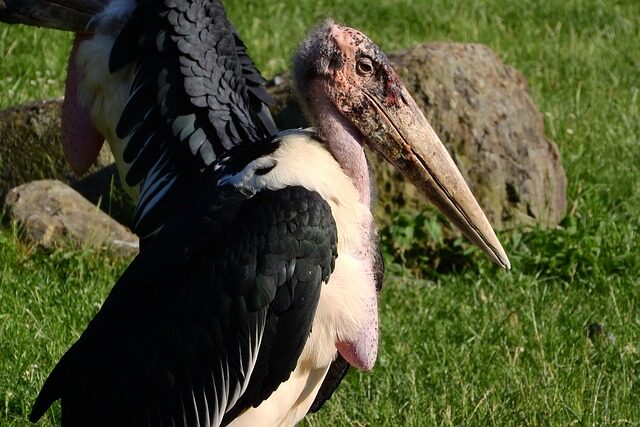
In African folklore, the marabou stork is often seen as a harbinger of misfortune. These birds are synonymous with death and are seen as harbingers of misfortune. This starkly contrasts with the symbolism of the white stork, celebrated for bringing life in the form of newborn babies.
According to one folklore, the marabou stork was crafted by God from the spare parts of other birds, which explains its unique and less aesthetically pleasing appearance. Despite these negative connotations, some cultures believe that the marabou stork embodies ancestral spirits and is thus respected and protected.
Gallery of the Giant Bird
Photographs of marabou storks provide a captivating glimpse into their lives in the wild. They showcase these birds in their natural habitats, interacting with other animals, and displaying their unique features. From images of marabou storks soaring high above the savannas to close-ups of their distinctive features, these photographs offer an intimate look at these fascinating creatures.
These images also capture the dynamic behavior of marabou storks. They are often seen engaging in their natural behaviors such as scavenging for carrion, standing atop trees, or foraging around grass fires. Their interactions with other animals, such as vultures, also make for compelling photographs.
In the Wild
The wild is where the marabou stork truly comes to life. Photographs capture the captivating scenes of marabou storks foraging for prey around grass fires, a common behavior in their natural habitat. These images paint a vivid picture of the bird’s opportunistic feeding habits and its adaptability to different environments.
Another fascinating aspect of marabou storks in the wild is their predatory behavior. Dramatic instances where marabou storks prey on other birds, such as adult flamingos, provide stirring moments for wildlife photography. These images underline the bird’s role as a top scavenger and its impact on the surrounding ecosystem.
Up Close and Personal
Detailed photographs reveal the unique characteristics of marabou storks. Their bare head and neck, devoid of feathers, offer a distinctive and easily recognizable look in close-up images. The marabou storks’ significant bill is another striking feature that allows them to feed effectively on carrion and other sources of food.
A distinctive pink gular sac at their throat is one of the unique features of marabou storks, which becomes particularly evident in detailed photographs. These photographs are essential for showcasing the unique characteristics of marabou storks, such as the texture of their bare skin, the gular sac, and the size of their bill.
Summary
In conclusion, the marabou stork is a unique and fascinating bird crucial in maintaining ecological balance across Africa. From its massive size and distinctive features to its scavenger lifestyle and opportunistic feeding habits, the marabou stork stands out in the avian world. Despite its grim reputation as the ‘undertaker bird’, it exhibits impressive adaptability and resilience in changing environments.
Conservation efforts are crucial to protect this intriguing bird species from threats such as hunting for traditional medicine markets. As we learn more about the marabou stork, we gain a deeper appreciation for its ecological importance and unique place in African folklore and culture. Remember, every creature, no matter how unusual or grim, has a vital role in our planet’s rich tapestry of life.
Frequently Asked Questions
What is the marabou stork known for?
The marabou stork is known for being a scavenger. It feeds mainly on carrion and animal scraps, which helps clean the environment by removing animal carcasses and stopping the spread of pathogens and bacteria.
Can marabou storks fly?
Yes, marabou storks can fly, and they do so majestically. They often fly solitary or in small groups, but they are sometimes seen in larger groups near sources of food while migrating or during breeding season.
Why is it called marabou stork?
The Marabou stork is called so due to its large size, with a wingspan of about 2.5 to 3 meters, and it can be found in large colonies all over Africa.
Are marabou storks edible?
Feasting on marabou storks is illegal and dangerous because they scavenge on waste and are exposed to pollutants. It is not recommended to eat them.
What are some interesting facts about the marabou stork?
Marabou storks are social birds that often gather near lakes or rivers and are known to hang around large mammals, including humans. They are generally quiet but may occasionally make grunts, croaks, or rattling sounds. Additionally, these large birds have a diverse diet, including carrion, fish, termites, locusts, and even baby crocodiles and snakes.

